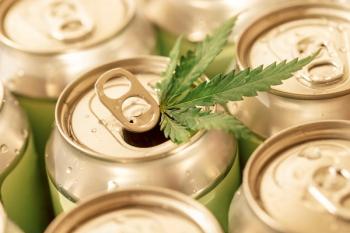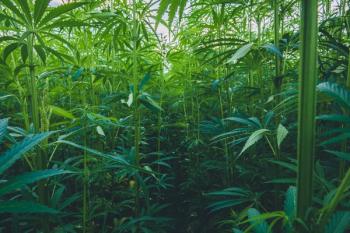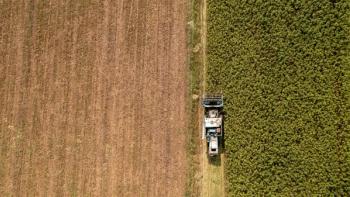
Cannabis Science and Technology
- September 2020
- Volume 3
- Issue 7
Rapid Analysis of 16 Major and Minor Cannabinoids in Hemp Using LC–MS/MS with a Single Sample Dilution and Injection
A rapid LC–MS/MS method is presented for the quantitative analysis of 16 cannabinoids in hemp samples with a single dilution protocol.
With the legalization of hemp in the US, there has been an influx of new hemp-based consumer products to market including dried hemp plants, drinks, vitamins, protein powders, and beauty products. In turn, innovative testing and analysis is required to ensure safety, quality, and labeling accuracy. A rapid liquid chromatography–tandem mass spectrometry (LC–MS/MS) method has been developed for the quantitative analysis of 16 cannabinoids in hemp samples with a single dilution protocol. Unlike traditional methods for cannabinoid analysis, this study did not require multiple detectors or multiple injections. The method is highly sensitive, and the limit of quantification (LOQs) of all cannabinoids were well below US limits for cannabinoids in hemp products. In addition, the method achieved a wide linear dynamic range with a good regression correlation fit (R2 > 0.99) for all 16 cannabinoids. The method therefore enabled quantitation of the cannabinoids over a range of 0.03–100% in hemp samples.
With the passing of the landmark Farm Bill by the United States congress in 2018, the growth and sale of hemp by farmers was legalized (1). Hemp, which can be used in consumable and beauty products ranging from beverages, vitamins, and protein powders to sunscreen and moisturizing lotions, is a strain of the Cannabis species and contains high concentrations of pharmaceutically active cannabinoids. Hemp naturally contains high concentrations of the cannabinoid cannabidiol (CBD), which is purported to have multiple medicinal uses for patients with epilepsy, pain, and nausea (2). Hemp also contains relatively smaller amounts of other cannabinoids such as tetrahydrocannabinol (THC). To ensure compliance with federal government regulatory requirements for hemp and help support quality control and labeling accuracy, hemp should contain less than 0.3% total THC. This is defined as the sum of THC and its acid form, tetrahydrocannabinolic acid A (THCA-A). According to United States Department of Agriculture (USDA) rules for hemp production, any hemp plant with a total THC level exceeding 0.3% (wt/wt) is considered marijuana, which remains classified as a Schedule I controlled substance regulated by the Drug Enforcement Administration (DEA) under the Controlled Substances Act. If a hemp farmer’s product exceeds the THC levels enforced by USDA rules, the product must be disposed of, resulting in an economic strain on the grower (3). Different strains of hemp and cannabis vary in their composition of cannabinoids depending on the plant’s tissue type, age, variety, growth conditions, harvest time, and storage conditions. The amount of different cannabinoids and their interaction may determine different effects and adverse side effects (4). It is therefore important to devise methods that can quickly and accurately determine different cannabinoids to distinguish different strains of hemp and cannabis products.
Traditionally, the most commonly used method for cannabinoid analysis in cannabis and hemp is gas chromatography (GC) coupled to a flame ionization detector (FID) or a mass spectrometry (MS) detector. This approach has limitations in correct quantitation of cannabinoids since they may thermally degrade in the GC injection port (5,6). Liquid chromatography (LC) with ultraviolet (UV) detection does resolve the limitations of GC methods for cannabinoid analysis due to decomposition (6–10), but the lack of selectivity with LC and the method’s narrow linear dynamic range can result in inaccurate quantification of cannabinoids in hemp and cannabis samples (11). Liquid chromatography tandem mass spectrometry (LC–MS/MS) offers much higher linear dynamic range, selectivity, and sensitivity compared to LC-UV and it can therefore be utilized for more accurate quantification of cannabinoids in the range of 0.1–100% with much higher selectivity than LC-UV (12–15).
This article describes the sample preparation and analytical method for the chromatographic separation and quantitative monitoring of 16 primary cannabinoids (covering seven different subclasses) in the hemp matrix by LC–MS/MS.
Experimental
Hardware and Software
Chromatographic separation was conducted on a PerkinElmer LX50 ultrahigh-pressure liquid chromatography (UHPLC) system, while detection was achieved using a PerkinElmer QSight 420 LC–MS/MS detector with an electrospray ionization (ESI) source. All instrument control, data acquisition, and data processing was performed using the Simplicity 3Q software platform.
Sample Preparation Method
The step-by-step sample preparation procedure is described with an overall dilution factor of 100,000. For each sample, approximately 5 g of ground hemp was used as a representative of each sample batch. In our method, hemp was already received after grinding and therefore there was no need for further grinding. Note that hemp plant material would need to be ground to smaller particle size for efficient extraction of cannabinoids if it was present in its native form. Next, 1 g of this ground sample was then weighed out into a 50 mL centrifuge tube on an analytical balance (±0.001 g). The weight of the sample aliquot was recorded and 3–4 replicates were produced from the representative sample of each batch. Then 30 mL of 80:20 methanol–water was added to the sample aliquot in the centrifuge tube, which was then capped. This extraction solvent composition comprising mainly methanol with a small amount of water has previously demonstrated good recovery of cannabinoids from hemp products (9,13). The centrifuge tube was placed on a vortex mixer and agitated for a total of 15 min, before being spun for 5 min at 3000 rpm.
Following centrifugation, the plunger of a 3 mL polypropylene disposable syringe was removed and a 0.22 µm nylon syringe filter was then secured onto the tip of the syringe. Next 1.5 mL of the supernatant from the centrifuge tube was removed with a disposable transfer pipette and transferred into the 3 mL disposable syringe. The plunger was then inserted into the syringe barrel and the supernatant was filtered through the 0.22 µm nylon filter into a 1.5 mL centrifuge tube. The filtered supernatant was diluted 1000-fold by adding 30 µL of filtered extract into 970 µL of solvent containing 80:20 methanol–water in a new 1.5-mL centrifuge tube, before being mixed thoroughly on a vortex mixer for ~10 s. The mixed extract was diluted 100-fold further by pipetting 10 µL of the filtered supernatant into 990 µL of 80:20 methanol–water in a 2 mL sample vial, giving an overall dilution of 100,000. This was mixed thoroughly on a vortex mixer for ~10 s and loaded into the LX-50 autosampler for analysis using the LC–MS/MS method described herein.
LC Method and MS Source Conditions
The HPLC–MS/MS method, LC gradient, MS source, and multiple reaction monitoring (MRM) parameters are shown in Tables I, II, and III, respectively.
Solvents, Standards, and Samples
All solvents and diluents used were LC–MS grade and filtered via 0.45 µm filters. Upon arrival in the analytical laboratory, all standards were further diluted using acetonitrile. The standards of 16 cannabinoids at a concentration level of 1000 ppm were obtained from Cerilliant. A stock standard containing 20 ppm of each of the 16 cannabinoids was prepared by adding 100 µL of each individual standard to 3.4 mL of acetonitrile solvent, bringing the total volume of standard to 5 mL. For calibrants, the mixture was serially diluted to give concentration levels of 0.003, 0.01, 0.03, 0.1, 0.3, 1, 3, and 10 µg/mL (ppm). The results reflect the averaged triplicate injections for all calibrants and samples.
Results and Discussion
Separation and Detection Limits of 16 Cannabinoids
Figure 1 shows the LC–MS/MS chromatogram of a standard containing 100 ppb of 16 cannabinoids, all well resolved in less than 9 min. The LC method was able to obtain baseline separation of all the analyzed cannabinoids including the resolution of critical pairs containing Δ9-THC–Δ8-THC and CBD–CBG. Table IV lists the retention time of the 16 cannabinoids in solvent standard. To check for possible analyte carryover or background interference, an acetonitrile blank was run twice, both after the calibration set and the samples. In all cases, no carryover was observed for any of the analytes. LC–MS/MS methods show good specificity for analysis of cannabinoids in the presence of other interfering compounds in hemp matrix such as terpenes, because they have very unique precursor and product ion masses. However, LC–MS/MS shows poor specificity for cannabinoid isomers unless they are separated in time, either by LC or ion mobility. Therefore, it was important to achieve the baseline resolution of isomers of neutral cannabinoids and acidic cannabinoids with LC conditions. Table III demonstrates clearly that the mass spectrometer cannot distinguish between isomers of neutral and acidic cannabinoids. For example, the MRM table shows that isomers of neutral cannabinoids such as THC-8, THC-9, CBC, and CBD have the same major product ions at nominal masses of 259 and 193 Da, with the same precursor ion mass of 315 Da. The MRM table shows that another isomer of these cannabinoids, namely CBL, has different major product ions in comparison to the major product ions for the other four isomers (THC-8, THC-9, CBD, and CBC). In this case, we would need to obtain baseline resolution of CBL with the other four isomers with LC for higher selectivity, since CBL’s minor product ions have the same mass as the major product ions of the other four isomers.
The optimization of the MS signal for cannabinoids showed that neutral cannabinoids and acid cannabinoids ionize better in positive and negative ion mode, respectively. Recent work published in literature has claimed that negative mode ESI can cause decarboxylation of acidic cannabinoids. The author of this article further postulated that this might result in a concern for quantitation of acidic cannabinoids in negative ion mode using LC–MS with no calibration or quantitation data (16). We did not observe decarboxylation of acidic cannabinoids in negative ion mode using ESI source in our instrument. Figure 2 shows MS spectra of an acidic cannabinoid (THCA) in negative ion mode using LC–MS conditions published in our work with very good signal for [M-H]- ion at mass of 357.2 Dalton only without any decarboxylation. We think that decarboxylation of acidic cannabinoids was observed in the earlier paper by inducing either in-source fragmentation using high voltage to accelerate ions from ion source to a mass spectrometry analyzer, or excess heat in the author’s source design. It is very common to induce in-source fragmentation of compounds using high voltage in an ESI source (17,18). In different ESI source designs on the market, these voltages are called either fragmentor, cone, or entrance voltages. In addition, another recent paper showed the possibility of measuring acidic cannabinoids in negative ion mode using an LC–MS/MS method with no calibration and quantitation issues and better detection limits for these compounds in negative ion mode as compared to positive ion mode (13).
Even in the case that decarboxylation results for acidic cannabinoids in negative ion mode were correct in the earlier reference with their ESI ion source parameters, as long as the LC method separates both neutral and acidic cannabinoids in time, there is no concern about quantification of acidic cannabinoids. Since we do not observe decarboxylation of acidic cannabinoids in negative ion mode and we are separating both acidic and neutral cannabinoids in time using our LC method, the concerns raised by the earlier paper (16) for quantification of acidic cannabinoids in negative ion mode are not valid for our LC–MS/MS method.
Since MS instruments are much more sensitive than UV detectors, it was possible to detect all cannabinoids with a limit of quantitation (LOQ) of 3 ppb or ng/mL. LOQ was determined based on a signal to noise ratio of 10 or more for quantifier transitions, as well as an ion ratio matching within 30% relative of the average expected ion ratio of qualifier to quantifier transitions of all the standards. Due to the very high dilution factor of 100,000 for hemp extract, we did not see any difference in noise level for all of the cannabinoids in both solvent standard and hemp extract. In addition, a higher dilution factor of hemp extract will result in minimal or no signal suppression for cannabinoids from hemp matrix. For the above reasons, we are justified in concluding that the LOQ for all of 16 cannabinoids would be quite similar in both solvent standard and hemp extract with a dilution factor of 100,000. Based on an overall dilution factor of 100,000, the detection limits of all the cannabinoids was 0.03% in hemp matrix.
The Linear Dynamic Range
The calibration curves for 16 cannabinoid standards were generated in a concentration range of 3–1000 ppb with MRM transitions based on monoisotopic ions as precursor ions. This enabled quantitation of the cannabinoids over a range of 0.03–10% in hemp samples diluted by factor of 100,000. There is the possibility that concentrations of major cannabinoids such as Δ9-THC, THCA, CBDA, and CBD could be higher than 10% in particular strains of cannabis flower, hemp, and their concentrated extracts. Therefore, for these samples, the calibration curves were extended to 10 ppm, which corresponds to 100% cannabinoid in samples based on an overall dilution factor of 100,000. Using 10 ppm is a relatively high level of cannabinoid for MS detectors. To overcome saturation effects, MS transitions of these compounds were also measured based on a first isotope as a precursor ion, which has 5–10 times lower signal than MS transitions based on a monoisotopic ion as a precursor ion.
By utilizing the calibration curves described above, it was possible to analyze major cannabinoids (CBD, CBDA, THC, and THCA) in a range of 0.03–100% without changing the dilution factor of samples. In previous studies, different groups have been able to measure these compounds in the range of 0.05–100% by using either two different injections with different sample dilution factors and UV detectors (9,10), or by using two different detectors (UV and MS) with different linear dynamic ranges (14). This new concept of measuring cannabinoid concentrations in samples over a wide dynamic range (0.03–100%) is significantly more cost effective because it does not require multiple injections or the use of two different detectors. This also results in a higher sample throughput compared to previously reported methods.
Approximately, 5-level or higher calibration fits were determined for all 16 cannabinoids. Representative linearity plots for CBD are shown in Figure 3 over a concentration range of 3 ppb to 1 ppm and 30 ppb to 10 ppm using MS transitions based on monoisotopic mass and its first isotope as a precursor ion, respectively. The R2 values for calibration curves of all of 16 cannabinoids were above 0.99. The accuracy of the calibration curve was checked by comparing back-calculated concentrations from a calibration curve with known concentrations of each cannabinoid and the criterion of maximum deviation of 15%. The precision studies showed that the relative standard deviation (RSD) of response of calibration standards was less than 10%.
Hemp Sample Analysis Using the LC–MS/MS Method
A sample of ground hemp, obtained from Emerald Scientific, Inc., was extracted with the described solvent extraction sample preparation method and present cannabinoids were quantified using the LC–MS/MS parameters described in Table I. Software was used to calculate the percentage of cannabinoids in the sample by considering the dilution factor and mass of the extracted hemp sample. To determine the amount of cannabinoids in the original hemp sample in wt/wt, we had to multiply the amount of cannabinoids determined in the hemp sample in g/mL of extract with a dilution factor of 100,000, since 1 mL of extract would be the equivalent of 10-5 gm of hemp sample. To further convert this wt/wt amount into % wt/wt, we had to multiply the above number by 100. The amounts of different cannabinoids measured in this hemp sample are listed in Table IV. Table IV also shows the calculated percentage of total CBD and THC by summing the acid and neutral forms of each (CBD + CBDA and THC + THCA). For this calculation, a correction factor of 0.877 was applied to the acid forms because of the extra molecular weight of the acid. The total amount of THC in this hemp sample was experimentally derived to be 0.176% (wt/wt), well below the USDA limit of 0.3% (wt/wt) for legal hemp product. Table IV also includes the calculated LOQs in hemp matrix for each cannabinoid, which were established based upon the dilution factor of 100,000, a signal to noise ratio over 10 for quantifier transitions, and an ion ratio matching within 30% relative of the average expected ion ratio of a standard.
Advantages of an LC–MS/MS Method for Cannabinoid Analysis in Hemp and Cannabis-Related Matrices Compared to Traditional Analytical Methods
LC–MS/MS provides higher selectivity and specificity for cannabinoid analysis compared to previously reported methods because it measures the unique fragments of each compound’s molecular ion. In comparison, LC-UV has much lower selectivity because it measures the signal of cannabinoids at a fixed wavelength of light, which can result in matrix interference caused by compounds found in cannabis such as terpenes. These compounds can give a signal at the same wavelength as cannabinoids and cause matrix interference if they coelute with cannabinoids in cannabis samples (11). A further advantage of this LC–MS/MS method for cannabinoid analysis is that the high dilution factor results in little contamination of chromatography columns by the sample matrix. This increases the methods cost effectiveness because the columns used will have an extended lifetime.
LC–MS/MS methods also provide high sensitivity due to advanced MS detectors, and minor cannabinoids can therefore be easily detected at levels of 0.03–0.1% or lower. This is achieved by utilizing a much higher dilution factor of 100,000 in comparison to the factor of 1000–6000 used for analysis of cannabinoids with LC-UV. The higher sensitivity of this method also means that calibration curves must be generated up to concentration levels of 1–10 ppm, compared to the much higher concentrations (50–250 ppm) required for previous LC-UV methods. The cannabinoid standards used to generate these curves are very expensive, and a 5–10-fold decrease in their consumption with the new LC–MS/MS method can represent an impactful cost-saving measure for laboratories. In addition, the use of a 10 times higher concentration of standards in LC-UV methods could exacerbate the LC autosampler carryover issues in LC-UV methods and this might lead to more inaccurate cannabinoid quantitation in cannabis and hemp samples compared to the results seen in the new LC–MS/MS method. A multiple sample dilution method with many injections would be needed to analyze both major and minor cannabinoids over a wide concentration range (0.1–100%) with UV detectors (9,10). This unique LC–MS/MS method can measure the cannabinoids over a wide range of 0.03–100% with a single sample dilution and injection.
Conclusion
This work has demonstrated the effective baseline chromatographic separation of 16 cannabinoids, including critical pairs of Δ9-THC–Ä8-THC and CBD–CBG. In a rapid 10 min LC–MS/MS method, 16 cannabinoids were quantitated in the range of 0.03–100% in hemp samples with a single dilution protocol and no carryover. The ground hemp sample tested in this work contained less than 0.3% total THC, as expected from legal hemp products. This LC–MS/MS method does not require use of multiple detectors (MS and UV) or multiple injections of samples with different dilutions to monitor both the low and high abundant amounts of cannabinoids in different hemp and cannabis related samples. In addition, the method can be easily extended to monitor cannabinoids in other cannabis-related samples including cannabis flower, concentrates, and edibles using a single dilution method with a single sample injection.
References
https://www.brookings.edu/blog/fixgov/2018/12/14/the-farm-bill-hemp-and-cbd-explainer/ .- T.W. Klein and C.A. Newton, Adv. Exp. Med. Biol. 601, 395–413 (2007).
- Establishment of Domestic Hemp Production Program, Rules and Regulations, Oct 31, 2019
https://www.govinfo.gov/content/pkg/FR-2019-10-31/pdf/2019-23749.pdf . - M.A. ElSohly and D. Slade, Life Science 78, 539–548 (2005).
- T.J. Raharjo and R. Verpoorte, Phytochem. Anal. 15, 79–94 (2004).
- A. Hazekamp, A. Peltenburg, R. Verpoorte, and C. Geroud, J. Liquid Chromatogr. Relat. Technol. 28, 2361–2382 (2003).
- S. Zivovinovic, R. Alder, M.D. Allenspach, and C. Steuer, J. Anal. Sci. Technol. 9, 27 (2018) doi:10.1186/s40543-018-0159-8.
- J. Steimling, Cannabis Science and Technology 1(4), 30–35 (2018).
https://www.perkinelmer.com/libraries/APP_High_Speed_Chromatographic_Analysis_of_16_Cannabinoids_014463A_01. - C. Young, B. Clifford, and G.J. Schad, LCGC 14(8), 27–32 (2018).
- A. Rigdon, C. Sweeney, C. King, B. Cassidy, J. Kowalski, and F. Dorman, "Method Validation for Cannabis Analytical Labs: Approaches to Addressing Unique Industry Challenges," presented at the Cannabis Science Conference, Portland, Oregon 2017.
- R.E. Kopec, R.M. Schweiggert, K.M. Riedl, and S.J. Schwartz, Rapid Commun. Mass. Spectrom. 27(12), 1392–1402 (2013).
- Q. Meng, B. Buchanan, J. Zuccolo, M.M. Poulin, J. Gabriele, and D C. Baranowski, PloS One 13(5), 1–16(2018).
https://sciex.com/Documents/tech%20notes/2019/Potency-Analysis-in-Hemp-and-Cannabis.pdf .- P. Berman, K. Futoran, G.M. Lewitus, D. Mukha, M. Benami, T. Shlomi, and D. Meiri, Sci. Rep. 8, 14280 (2018) doi:10.1038/s41598-018-32651-4.
- P.J.W. Stone, S. D’Antonio, N.C. Lau, W.A. Hale, and A. Macherone, Cannabis Science and Technology 3(3), 34–40 (2020).
- L. Abranko, J.F Garcia-Reyes, and A.J. Molina-Diaz, J. Mass Spectrom. 46, 478−488 (2011).
- V. Gabelica and E. De Pauw, Mass Spectrom. Rev. 24, 566−587 (2005).
About the Authors
Avinash Dalmia and Jacob Jalali are with PerkinElmer Inc., in Shelton, Connecticut. Saba Hariri, Erasmus Cudjoe, and Feng Qin are with PerkinElmer Inc., in Woodbridge, Ontario, Canada.
Direct correspondence to:
How to Cite this Article
A. Dalmia, J. Jalali, S. Hariri, E. Cudjoe, and F. Qin, Cannabis Science and Technology 3(7), 18-25 (2020).
Articles in this issue
about 5 years ago
The Pet Lab Syndromeabout 5 years ago
To Grind or Not To Grindabout 5 years ago
Budtender: Is That a Harmful Mold in My Bud?about 5 years ago
The Hidden Costs of Falling FilmsNewsletter
Unlock the latest breakthroughs in cannabis science—subscribe now to get expert insights, research, and industry updates delivered to your inbox.




